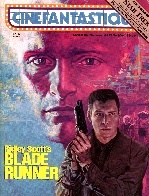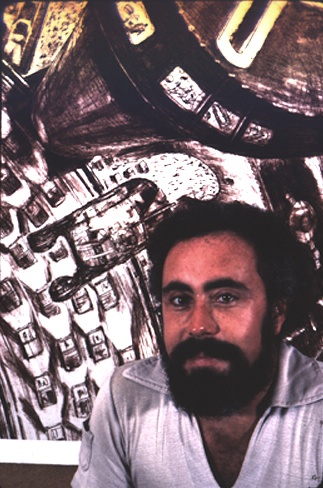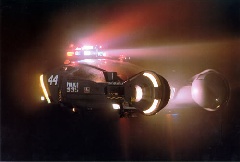Paul M. Sammon Interview
| What is BR? |
| News & Views |
| The FAQ |
| Encyclopedia |
| Quotes |
| People |
| Locations |
| Scripts |
| Analysis |
| Fan-tastic |
| BR Fun |
| BR Game |
| BR Magazine |
| BR Comic |
| Downloads |
| Collectibles |
| Related |
| Links |
| Site Info |
| Search Site |
BRmovie.com is the Home of Blade Runner - the current Blade Runner FAQ, news, resources, links, quotes, scripts and everything else Blade Runner.

![]()
Blade Runner
Buy this Mini Poster at AllPosters.com
|
Any
Comments?
Please e-mail the Webmaster |
| Want the DVD? Or the BR Game? Don't know which books or music to get? Maybe you'd like a Deckard action figure? Make sure you check the BR Related section for all your BR choices. |
|
N: What was your initial approach to doing the Omni and Cinefantastique articles and what were your first impressions of BR? PS: Well, before I'd acquainted myself with the nuts and bolts of the production, I'd initially felt that I'd be lucky to just get a few readable articles out of the thing. I mean, the Phil Dick angle was a given - that's one of the reasons I accepted the assignment in the first place. I'd been reading and loving the quintessential strangeness of Dick's prose since my adolescence. "What, they're making the first motion picture based on a story by Philip K. Dick? And you want me to write about it? I'm there!" So I knew that I'd at least get a Dickian-slanted piece out of this assignment.
That's when I started to lobby Fred Clarke, the late editor of Cinefantastique - Fred wasn't an easy guy to deal with, but I'm still saddened by his suicide - to allow me to compose a full-blown cover story on Blade Runner. Fred resisted that pitch at first, as I recall. In fact, I had to convince him that the story behind the making of BR was worth a 25,000-word article and dozens of color photographs. But once production started, and Warner Brothers and Brighton were kind enough to allow me to forward some advance Blade Runner art on to Clarke, Fred came around to my way of thinking.
N: So how exactly did those early articles eventually lead to a book on the making of Blade Runner? PS: As I've mentioned, I never initially saw my BR reportage in terms of a book. You see, I've always been an active person, professionally and personally. Still am; physically, I'm somewhat hyper, and I can't stand wasted time. Not that I necessarily feel that sitting out in the garden watching house finches build bird nests is wasting time. I don't mean that at all. But, religiously speaking, I'm sort of a suspicious agnostic who's still inclined to suspect that once your life is over, it's OVER. That's it. No heaven, no hell, no Mothership, no reincarnation, no second chance. So my initial BR writings were only tiny blips on an ongoing "career radar screen", so to speak. I loved being around the picture while it was being made, yeah. And I loved writing about it. But then I moved on. Yet, for some reason, I couldn't shake BR out of my head. It became sort of a mental splinter, one I couldn't ignore or get rid of. Why? Because, very early on, and like other viewers after me, I'd begun to sense the different layers scattered throughout the film. Plus, I'd already started to gain a rep as "Mr. Blade Runner," this walking repository of BR lore. So, over time, I began writing other pieces about the film. And one day, critical mass was achieved. That was the afternoon I called up Ridley Scott and my literary agent, Lori Perkins, and said, "Look, I'm toying with the idea of doing a book on Blade Runner. A definitive book. What do you think?" Lori and Ridley both said they thought it was a great idea. Which was a good thing. Otherwise, you and I wouldn't be talking! (laughs) There's a minor story here, by the way. A little footnote to the film's history I don't believe I've related before. It concerns Syd Mead's preproduction paintings. The ones that were done before filming began. Which you still see today; the most ubiquitous one is this blue-hued illustration of a Spinner flying through a cityscape. Well, that art was first photographed through the efforts of yours truly.
I still remember how we shot Syd's art one afternoon in this little alcove next to Ridley's office, which at the time was located in the old Gower Gulch building, where Brighton was first based. This was before the production company had moved onto the Warners lot. Anyway, I remember setting up this little easel before carefully placing Syd's art on that stand. The pieces themselves were small, about 10 by 15 inches. Next, I helped with the lighting and such, and then stood around while the photographer shot Syd's work on reversal stock, which is what is used to produce transparencies. Then, after those slides were developed, Brighton loved them so much we made extra sets for them and for Warner Brothers. Of course, I also sent a set on to Omni, too. And now, 20 years later, I still see reproductions of those darn things. They pop up everywhere. So there's a little slice of BR I don't think anyone's been served before.
|

 As
for my initial thoughts about Blade Runner itself, well,
who knew? Don't forget, this was the early 1980's. Hollywood's infatuation
with science fiction at that point was resulting in far too many
mega-productions with super special effects and dismal everything
else. So I went into the Brighton office's that first day...well,
not exactly expecting the worst, but prepared to accept it. Then
I read BR's script, and met Ridley and visited the art department.
And it quickly became clear to me that Blade Runner was sincerely
striving to achieve something special; its approach was going to
be anything but your stereotypically banal "sci-fi adventure".
It all looked very, very promising.
As
for my initial thoughts about Blade Runner itself, well,
who knew? Don't forget, this was the early 1980's. Hollywood's infatuation
with science fiction at that point was resulting in far too many
mega-productions with super special effects and dismal everything
else. So I went into the Brighton office's that first day...well,
not exactly expecting the worst, but prepared to accept it. Then
I read BR's script, and met Ridley and visited the art department.
And it quickly became clear to me that Blade Runner was sincerely
striving to achieve something special; its approach was going to
be anything but your stereotypically banal "sci-fi adventure".
It all looked very, very promising.
 Ridley
had showed me about a half dozen of Syd's early paintings during
BR's prep period, and they were so impressive I immediately
got on the horn and managed to convince my Omni editor that
her magazine should hire a photographer who could shoot this art
in the most flattering way possible. Omni then would be able
to use selections of that art to illustrate the articles I was going
to write for them. And that's what happened. Omni hired a
local professional, I set up the shoot between him and Brighton,
and the end result was a lot of fun. For me, anyway.
Ridley
had showed me about a half dozen of Syd's early paintings during
BR's prep period, and they were so impressive I immediately
got on the horn and managed to convince my Omni editor that
her magazine should hire a photographer who could shoot this art
in the most flattering way possible. Omni then would be able
to use selections of that art to illustrate the articles I was going
to write for them. And that's what happened. Omni hired a
local professional, I set up the shoot between him and Brighton,
and the end result was a lot of fun. For me, anyway.